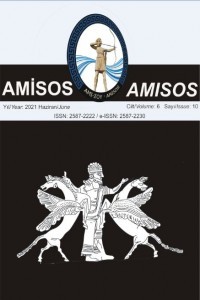A FIGURED OSTOTHEK LID FROM THE ROMAN PERIOD
Ilgın, Tomb, Lion figure, woman Figure, stylistic, Iconography
___
- Altun, S. 2016, “İsaura Antik Kenti Nekropolleri”, SEFAD 36, 2016 s. 497-506.
- Asgari, N. 1965, Hellenistik ve Roma Çağlarında Anadolu Ostothekleri, İstanbul Üniversitesi Yayınlanmamış Doktora Tezi, İstanbul.
- Baldıran, A. 2005, “Taşkent-Avşar Ostotekleri”, Hacettepe Üniversitesi Edebiyat Fakültesi Dergisi, C 22, S 2, 67-86, Ankara.
- Bossert, H. Th. 1942, Altanotalien Kunst und Handwerk in Kleinasien von den Anfängen bis zun volligen Aufgehen in der Griechischen Kultur, Berlin.
- Buckler, W. H. 1924, “Asia Minor, Monuments from Iconium, Lycaonia and Isauria”. The Journal of Roman Studies. C. 14, s. 24-84.
- Çelgin, A. V. 1990, Termessos Kenti Nekropolleri, İstanbul Üniversitesi, Sosyal Bilimler Enstitüsü (Yayınlanmamış Doktora Tezi), İstanbul.
- Daylan, N. E. 2020, Güney Lykaonia ve İsauria Bölgesi Aslanlı Ostotek Kapakları, Selçuk Üniversitesi Yayımlanmamış Yüksek Lisans Tezi, Konya.
- Doğanay, O. 2009, İsauria Bölgesi Kaya Mezarları ve Ölü Gömme Gelenekleri, Çizgi Kitap Evi, Konya,
- Doğanay, O. 2016, “Zengibar Kalesi (İsaura) 2010-2015 Yılları Yüzey Araştırmaları: İlk Sonuçlar ve Düşünceler”, İdil 5. 21, 390-403.
- Er-Scarborough, Y. 1991, The Funerary Monuments of Cilicia Tracheia (Cornell Üniversitesi Yayınlanmamış Doktora Tezi), New York.
- Ferguson, G. 1954, Signs ann Symbols in Christian Art, Newyork.
- Górecka-Smolinska, M. - Kleparski, G. A. 2008, “On The Symbolism Of Mammals In The Cultures Of The World- An Outline”, ZESZYT 51, 22-35.
- Haspels, C. H. E. 1971, The highlands of Phrygia: Sites and monuments, I-II, New Jersey,
- Işık, F. 2006, Phryg Dini, Tek Tanrıça Matar Kubeleya, Arkeoatlas 5, 47-52.
- Koch, G. 2001, Roma İmparatorluk Dönemi Lahitleri, Arkeoloji ve Sanat Yayınları, İstanbul, s. 219.
- Köse, V. 2005, Die Nekropolen und Grabdenkmäler von Sagalassos in Pisidien in Hellenistischer und Römischer Zeit VII, Brepols publishersn.
- MAMA VII, 1956, Monumenta Asiae Minoris antiqua: Monuments from Eastern Phrygia, Ed. W.M. Calder, Manchester.
- MAMA XI, 1957, Monumenta Asiae Minoris Antiqua. Kaynak: http://mama.csad.ox.ac.uk/monuments/MAMA-XI-204.html.
- Mclean, B. H. 2002, Greek and Latin Inscrıptıons In The Konya Archaeologıcal Museum, Ankara: British Institute of Archaeology.
- Pfuhl, E. - MÖBİUS, H. 1977, Die Ostgriechischen Grabreliefs, I. Mainz: Verlag Philipp von Zabern.
- Şahin, M. 2000, Miletopolis Kökenli Figürlü Mezar Stelleri ve Adak Levhaları, TTK Basımevi. Ankara.
- Taşkıran, H. 2018, “Prehistorik Arkeoloji ve Mağaralar”, Mavi Gezegen, Sayı 24, 62-68.
- Toynbee, J.M.C. 1971, Death and Burial in The Roman World, Ithaka published, New York.
- Yılmaz, M. 2005, Bozkır Çevresinin (Hadim-Ahırlı-Yalıhüyük) Antik Tarihi ve Eserleri: “Isauria”, Selçuk Üniversitesi Basımevi, Konya.
- ISSN: 2587-2222
- Yayın Aralığı: Yılda 2 Sayı
- Başlangıç: 2016
- Yayıncı: Davut YİĞİTPAŞA
ARTEMİSİA GENTİLESCHİ’NİN TASVİRLERİNDE “BAT-ŞEVA” İKONOGRAFİSİ
İPSALA’DA BİR OSMANLI HATIRASI: ALACA MUSTAFA PAŞA CAMİİ
JOHN RUSKIN VE YEDİ YOL GÖSTERİCİ IŞIKTAN “BELLEK”
AİZANOİ ANTİK KENTİ’NDEKİ GLADYATÖR BETİMLERİ
ROMA SİYASETİNDE ASKERİ GÜÇ: AELİUS SEİANUS
TRALLEIS KAZISI GYMNASIUM ALANINDA 2007 YILINDA BULUNAN ROMA SİKKELERİ
A FIGURED OSTOTHEK LID FROM THE ROMAN PERIOD
TATARLI HÖYÜK HİTİT İMPARATORLUK DÖNEMİ SERAMİKLERİNDE ÇÖMLEKÇİ İŞARETLERİ
